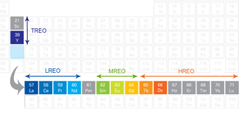The Mosandrite Mineral
Mosandrite is a mineral of a similar level of rarity as the red gemstone Eudialyte (the latter is used commonly in jewelry and other, more esoteric aspects of mineralogy), and the composite geological rock Britholite. More specifically, the gold-hued Mosandrite is comprised of so many different rare-earth metals, that is it sometimes simply referred to as a rare-earth metal, itself, in the literature. Moreover, it is one of the few metals from the Lanthanide-Actinide series of chemical elements (be sure to note that it is not an element, itself, being comprised of so many different substances) that is truly very, very rare. More precise specifications as to the structural nature of this prized mineral are that it is a complex Sorosilicate, and possesses a low-level of radioactivity due to the presence of the heavy element Cerium in its structure.
Although Mosandrite is loosely classified as a crystal (mineralogists generally have several different classifications for any particular substance), it isn’t found in gem quality, which makes it somewhat difficult to use as un-alloyed jewelry. Mosandrite is found in Canada, Norway, South Africa and Greenland; although the most common place – where it is nonetheless extremely rare – is the Murmansk District of Russia, in the mountains of Kukisvumchorr, and the Kola Peninsula.
As is usually the case with extremely involved minerals like Mosandrite (for example, Eudialyte, rinkite/rinkolite, Britholite, feldspar), the chemical structure is far from a static representation, and the exact characteristics often depend on the region from which that particular species was mined. For example, geological physicists sometimes refer to Johnstrupite as Mosandrite from Greenland, after the name of the region from which it was found. In fact, it can be so variable that many mineralogists use the names Rinkite, Rinkolite and Mosandrite interchangeably, to represent the fact that sometimes the only thing that differs between the range of elements that comprise their structure is the arrangement of a few of them. Sodium, calcium, cerium, titanium, niobium, aluminum, zirconium, silicates, oxygen and fluorine are many of these building-block elements. As one would expect, Mosandrite and his cousins behave in very similar ways, and are often indistinguishable except under discrete chemical analysis.
It is noteworthy that Mosandrite was discovered midway through the nineteenth century by a Swedish scientist, Carl Gustav Mosander; he was also responsible for related discoveries of rare earths. Of interest to chemists and geologists alike are its properties:
- Mosandrite is classified as a Sorosilicate, with a sphenoidal crystallography and prismatic form; the latter metric refers to its so-called crystal habit (the shapes it is likely to form under gravity, which is a function of physical and chemical factors). It turns out that Mosandrite tends to fall into a prism form when under no external influence other than nature.
- Mosandrite has a cleavage property classified as good, which are essentially 4 on a scale of 5. This means that when it is broken or unduly stressed, it will break in a very clean fashion, with a minimum of roughness in the separated pieces; they tend to be planar. This is suggested by its prismatic crystal habit.
- Mosandrite has a Moh’s Hardness value of 4.0, which is about as resilient as fluorite, which means that a knife made of steel or iron can scratch it with little effort. Moh’s hardness is essentially a measure of “what is hard enough to scratch what”, and in ascending order from known resilient materials, there’s quartz, topaz, corundum, and of course the master of them all, diamond.
- It has a luminescence of none; which may be surprising because of its avowed radioactivity. Luminescence refers to the ability to emit non-thermal heat, as from chemical reactions. The radioactivity of the minute amounts of cerium in Mosandrite is too low to emit any real amount of heat.
- It has a density of 3.29 grams per cubic centimeter.
- The common color of Mosandrite is a mixture of bright yellows and tan to medium browns. It can have some greens mixed in as well.
- Mosandrite is translucent; variations with fewer chemical impurities can be transparent – although colored with the characteristic yellow.
- It has a glass-like luster.
- A few other places of origin that might not have been mentioned above are Nordic provinces, such as Langesundsfjorden, Larvik, Laven and Vestfold.
- Mosandrite has a molecular weight of about 913.4 grams.

